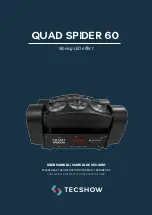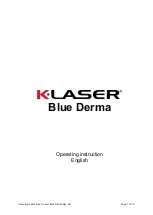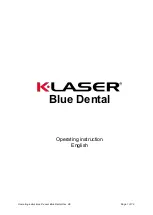
GSI Novus™ Newborn Hearing Screening System User Manual
D-0113050 Rev H
Page 77 of 96
A
PPENDIX
B:
P
ASS
/R
EFER
C
RITERIA
,
S
ENSITIVITY AND
S
PECIFICITY
D
EFAULT
P
ROTOCOLS
The criteria used for the Pass/Refer results are contained in the protocols supplied with
the Novus. The specifications of these protocols are listed in the Test Specification in
Appendix A. The default protocols supplied with the Novus were used to determine the
sensitivity and specificity.
ABR PASS CRITERIA
•
The Automatic Response Detection Algorithm uses fast Chirp stimulation (90
stim/s) at a level of 35 dB nHL
•
The Amplitude and Phase of each of the first eight harmonic frequencies
(multiples of 90 Hz) are used by a Modified Q-sample test to calculate a statistical
test variable
•
Pass criteria: statistical test variable compared to the detection criteria (selected
for theoretical 99.9% sensitivity) and if greater than the detection criteria result is
a PASS
TEOAE PASS CRITERIA
•
Signal to noise ration minimum: 4 dB
•
Minimum response amplitude: -5 dB
•
Pass criteria: 3 of the 4 bands (1400, 2000, 2800, 4000 Hz) must meet the criteria
for an overall pass
DPOAE PASS CRITERIA
•
Signal to noise ration minimum: 6 dB
•
Minimum response amplitude: -5 dB
•
Pass criteria: 3 of the 4 bands (2000, 3000, 4000, 5000 Hz) must meet the criteria
for an overall pass
S
ENSITIVITY AND
S
PECIFICITY
T
ESTING
M
ETHOD
It is widely acknowledged that sensitivity testing requires an artificial test environment
that simulates severe hearing impairment. For OAE sensitivity assessment, an acoustic
test cavity is selected to provide an appropriate acoustic test load to the probe. For ABR
sensitivity assessment the electrodes are normally attached to a resistive load
approximately equivalent to the typical electrode impedance experienced in the clinical
situation.
However, a more thorough assessment requires the inclusion of clinically equivalent
noise into the measurement. To achieve this, a ‘head simulator’ was designed and built
that provides the combination of:
•
an infant sized ear canal acoustic impedance,
•
e
lectrode attachment points connected to a 2kΩ star configured set
of resistors,
•
2 different fully controllable noise generators (one pink and the other being a
long recording of acoustic noise typical in a clinic)
















































